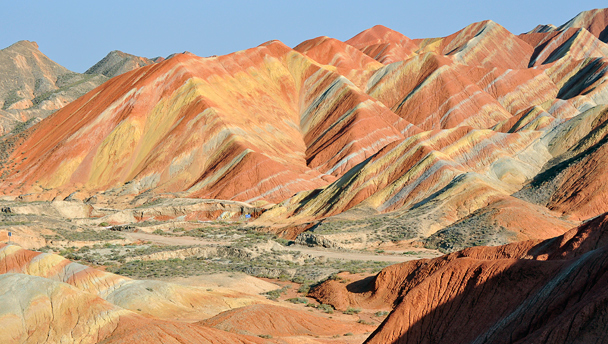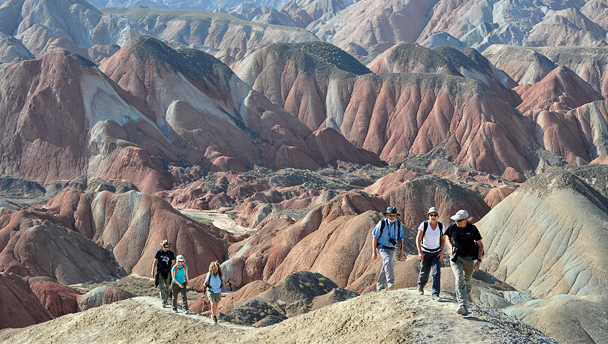Zhangye Danxia Landform, Gansu Province
See the fantastically-coloured mountains and cliffs in an all-but unexplored area of Gansu; visit Horse Hoofprint Temple, Jiayuguan Fortress, and more.

Jiayuguan and Zhangye, Gansu Province
The name of the province we’re visiting, Gansu, was first used in the Song Dynasty (960–1279 AD), after two areas belonging to previous dynasties were combined. One area was previously named Gan; the other, Su.
The Silk Road passed through Gansu, following a narrow route between the Tibetan Plateau (too cold!) and the Gobi Desert (too hot!) that’s known as the Hexi Corridor.
Zhangye was one of the stops on the Silk Road, and Jiayuguan was at the westernmost end of the area controlled by the Ming Dynasty. While the main focus of this trip is the Danxia Landform, the Buddhist sites and relics left by Silk Road travelers, and the Great Wall in the area of Jiayuguan, are also well worth a look.
Trip overview
Day One
Fly from Beijing to Jiayuguan; visit Jiayuguan Fortress; overnight in hotel.
Day Two
Private bus to Zhangye, check in to hotel in Zhangye; hiking in Danxia Landform; visit Zhangye’s Giant Buddha Temple; overnight in Zhangye.
Day Three
Hiking in Binggou Rock area; overnight in Zhangye.
Day Four
Visit Horse Hoof Temple and hike; private bus to Jiayuguan; overnight in hotel.
Day Five
Visit First Beacon Tower of Ming Dynasty Great Wall; fly back to Beijing.
Highlights

Hike deep into the hills and valleys of the Zhangye Danxia Landform.
Zhangye Danxia Landform
China boasts many different kinds of unique and beautiful landscapes, from towering limestone karst mountains to expansive grasslands that reach as far as the eye can see. Formed from red sandstone beds by combination of erosion and uplift, the Danxia Landforms are also spectacular sights. Some Danxia Landforms have been listed as UNESCO World Heritage Sites.
Danxia landforms are sandstone formations, known for being very dramatic and colorful. The landform near Zhangye City has colourful and magnificent cliffs in a hilly and mountainous land. Danxia refers to isolated peaks, steep pillars, ravines, mountains and hills that have formed after a long period of erosion by wind and running water. Unlike limestone karst, Danxia landforms are composed of red sandstone, which gives them their characteristic crimson colouration. Several Danxia Landforms are listed by UNESCO as World Heritage Sites because of their profound natural and aesthetic value. The area we’re visiting boasts majestic, multi-coloured slopes that give you the sensation of walking into a painting.
The Zhangye Danxia Landform is characterized by magnificently multi-coloured sandstone hills and mountains that ripple away towards the horizon. The area we’ll be visiting was used as the backdrop for the Zhang Yimou film, “A Woman, A Gun, and A Noodleshop.”
Temples and Buddhist sites near Zhangye
The Silk Road passed through Zhangye, bringing many travelers, but nowadays many choose to head straight to Jiayuguan. While in Zhangye, we’ll visit the Giant Buddha Temple, and the Horse-Hoof Temple and Caves.
Giant Buddha Temple
Built in 1098 AD, and extended and renovated during the Ming and Qing Dynasties, Zhangye’s Giant Buddha Temple houses the largest indoor reclining Buddha in China—nearly 35 metres from head to toe. The reclining pose signifies entry into nirvana. We’ll also see a variety of architectural styles in the temple, with the Ming and Qing Dynasties represented, amongst others.
The temple was built here after the Emperor of the time's tutor in Buddhism followed the sound of heavenly music and found buried an ancient statue of Buddha, reclining in the same nirvana pose of the Buddha we'll see in the temple.

Snowy mountains behind the caves of the Horse Hoof Temple, built into the side of a cliff. View a larger photo »
Horse Hoof Temple and Caves
The site of the Horse Hoof Temple has been in use since at least the Eastern Jin Dynasty (317–420 AD), and the snowy Qilian Mountain range makes a beautiful backdrop. It’s best known for its Hanging Temple and grottoes, and is a little similar to the famous Mogao Grottoes in Dunhuang, although less-visited. Some caves and relics were damaged by treasure-hunters, and damage was also done during the Cultural Revolution.
Han Dynasty and Ming Dynasty relics near Jiayuguan
Some of the earliest Great Wall was built during the Han Dynasty (206 BC–220 AD), including a line of rammed earth ramparts that stretched out into the desert. It’s said that these fortifications, and the soldiers stationed on them to repel attacks from nomadic tribes and bandits, played a large role in making the Silk Road safer for travelers and increasing the volume of trade along the way..
Some Han Dynasty sites remain, and on this trip we’ll visit ancient tombs to see frescoes that are illustrative of the customs and dress of the times, and we’ll take a look at a section of the Han Dynasty wall known as the Hanging Wall, said to have been restored using the Han Dynasty construction techniques.
The fortress at Jiayuguan marked the western end of the main line of Ming Dynasty (1368–1644 AD) Great Wall, but some watch towers were built further to the west. Near a deep canyon, we’ll find ‘The First Beacon Tower’, built to give early warning, via smoke signal, of approaching attackers.

The West Gate of Jiayuguan Fortress, seen from the desert outside the walls.
Jiayuguan Fortress
Jiayuguan Fortress is known as the western-most end of the Ming Dynasty Great Wall, and was one of the most important fortifications of its time, guarding the western entrance to China from the Hexi Corridor. The fortress has three defense lines – a moat, an outer city wall, and an inner city wall. There are gates on the east and west side. The fortress looks spectacular, with Great Wall climbing from it to the mountains in the north and south, and multi-storey towers and halls inside the walls and moat. We’ll visit the fortress on the first day of the trip.
In ancient times, banishment was a common form of punishment. If you were banished ‘to the West’, it's out through the west gate of the Jiayuguan Fortress that you'd pass.
Weather
May is one of the best times of the year to visit the area, with an average high temperature of 23°C, an average low of 8°C, and not much chance of rain.
Accommodation
We will be staying in 4-star hotels in Jiayuguan and Zhangye.
You’ll be sharing a room at the hotel with another hiker. If you'd like a room to yourself, it can be arranged at an extra cost of 750 RMB for the whole four nights, if a room is available—usually not a problem!
Further details about room shares and single supplement can be found in the documents we send you as part of the registration.
Flights and transport
We fly to and from Jiayuguan for this trip. Transportation between Jiayuguan, Zhangye, and the various scenic locations will be by private bus.
Frequent flyers: Please let us know if you would like to use your frequent flyer miles or if you are a frequent flyer member. If you would like to organise your own flights, we can provide further details.
Food
We will take most of our meals at restaurants in the areas we visit, or at the hotels or guesthouse. On one of the days we include a picnic lunch for you. Bring some spending money for snacks during the trip. Please let us know if you have any special dietary requirements or food allergies.

On the third day of the trip we hike in the Binggou Rock area, where we'll see tall, eroded cliffs and outcrops.
More photos
- Photos from our May 2013 visit to the Danxia Landform in Zhangye
- Photos from our October 2011 visit to the Danxia Landform in Zhangye
- Photos from our May 2011 visit to the Danxia Landform in Zhangye
Things to bring
- Passport/ID card
- Waterproof jacket and trousers
- Thermal underwear and other warm clothing (it could get cold!)
- Gloves
- Hat
- Thick socks
- Hiking boots
- A day pack to take on outings, suitcases or bigger bags can be left at the hotel
- Camera and charger, batteries
- Suncream
- Torch or headlamp
- Mobile phone, charger
Full itinerary
-
Day One
10:00 – Meet at the Beijing Capital Airport for an 11:20 flight (exact time TBC)
15:50 – Arrive at Jiayuguan
16:30 – Visit Jiayuguan Fortress (approx. 20 minutes from airport)
18:30 – Check in at hotel (15 minutes' drive from fortress)
19:30 – Dinner at hotel, rest or take a stroll after dinner -
Day Two
07:30 – Up early for breakfast, check out, and drive to Zhangye
11:30 – Check in at Zhangye hotel, prepare for a hike
12:00 – Walk up to the first lookout in the Danxia Landform
12:30 – Continue the walk through the park area
13:00 – Hike up to the second lookout in the park
14:00 – Finish the walk and take the park bus back to the entrance
14:30 – Late lunch at local guide's guesthouse
15:30 – Drive back to Zhangye, visit the Giant Buddha Temple
16:30 – Back at hotel, free time
19:00 – Dinner at hotel -
Day Three
08:30 – Breakfast at the hotel
09:00 – Drive to the start of a loop hike in the Binggou Rock part of the Danxia Landform
09:40 – Start hiking
10:30 – Arrive at the first lookout, then hike down into the valley
13:30 – Picnic at the highest lookout
14:30 – Finish the hike, drive over to White Stone Valley for more hiking
15:00 – Start hiking
17:00 – Finish hiking, drive back to Zhangye City
19:00 – Dinner at local restaurant -
Day Four
08:00 – Breakfast
09:00 – Drive to Horse Hoof Temple
10:00 – Tour frescoes and caves in the temple
12:00 – Lunch
13:00 – Hike in the hills behind the temple
15:00 – Depart for Jiayuguan
18:00 – Dinner after checking in at the hotel -
Day Five
09:00 – Breakfast and check out
10:00 – Drive out to the First Beacon Tower of the Great Wall
10:30 – Visit First Beacon Tower and surrounding area
13:00 – Lunch
14:00 – Head to the airport for a 16:40 flight
21:10 – Arrive back in Beijing
All times are approximate, and depend on our speed of movement.















